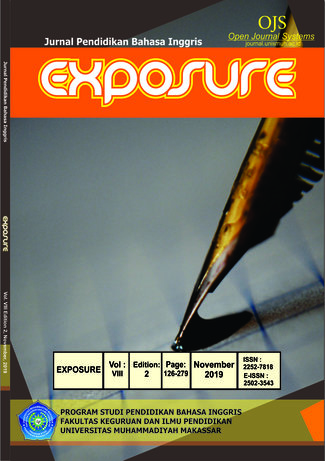TEACHING STRATEGIES USED BY THE LECTURERS AND STUDENT’S RESPONSE IN ENGLISH SPEAKING CLASS
DOI:
https://doi.org/10.26618/exposure.v8i2.2803Keywords:
Teaching strategies, English, Speaking classAbstract
This research aimed to find out teaching strategies used by the lecturers and the Students’ Response to the teaching strategies used by the lecturers in English Speaking Class. This research used a quantitative method. The population of this research was the third-semester students while the sample was 60 students from that population that was taken selectively. The instruments of this research were observation and questionnaire. The first lecturer used telling the story and oral interview while the second lecturer used to role-play and oral interview. Students’ response in the first class for telling story strategy strongly agreed 22.50 %, agree 50.42 %, neutral 24.58 %, disagree 2.08 %, strongly disagree 0.42 %. Therefore, the score range was 3.93. While for oral interview strategy were strongly agree 24.29 %, agree 47.62 %, neutral 26.19 %, disagree 1.90 %, strongly disagree 0 %. Therefore, the score range was 3.94. Students’ response in the second class for role-play were strongly agree 9.58 %, agree 45.83 %, neutral 24.17 %, disagree 14.17 %, strongly disagree 6.25 %. Therefore, the score range was 3.38. While for oral interview strategy were strongly agree 12.38 %, agree 38.57 %, neutral 33.81 %, disagree 8.10 %, strongly disagree 7.14 %. Therefore, the score range was 3.41. The result showed feedback on in the first class, it has been proven that more attractive lecturers to students than the “storytelling” strategy on the first-class use the “oral interview” strategy. Whereas in the second class, it has been proven that lecturers use the “oral interview” strategy is more attractive to students than the "telling story" strategy on the Second class.
References
Abdillah, L.N.P. 2013. Strategies in Teaching Speaking to English Department Students at Muhammadiyah University of Surakarta. Undergraduate Thesis. Surakarta: Muhammadiyah University of Surakarta.
Bryson, J. M. 2004. Strategic planning for public and nonprofit organizations: a guide to strengthening and sustaining organizational achievement (3rd Ed.). San Francisco: Jossey-Bass.
Budden, J. 2006. Role-play. UK, London: BBC.
Kayi, Hayriye. 2006. Teaching Speaking: Activities to Promote Speaking in a Second Language.
Nuh, Sunyoto. 2017. Designing L2-Based Communication Strategies Teaching for Speaking Class. Undergraduate Thesis. Bandar Lampung: Lampung University.
Riduwan. (2014). Metode & Teknik Penyusunan Proposal Penelitian. Bandung: Alfabeta.
Silver, Harvey F., Richard W. Strong., & Matthew J. Perini. (2007). Strategi- Strategi Pengajaran. Jakarta: PT. Indeks.
Sugiyono. (2017). Metode Penelitian Kuantitatif Kualitatif dan R&D. Bandung: ALFABETA
Downloads
Published
Issue
Section
License
Authors who publish with this journal agree to the following terms:
In order to assure the highest standards for published articles, a peer review policy is applied. In pursue of the compliance with academic standards, all parties involved in the publishing process (the authors, the editors and the editorial board and the reviewers) agree to meet the responsibilities stated below in accordance to the Journal publication ethics and malpractice statement.
Duties of Authors:
- The author(s) warrant that the submitted article is an original work, which has not been previously published, and that they have obtained an agreement from any co-author(s) prior to the manuscript’s submission;
- The author(s) should not submit articles describing essentially the same research to more than one journal;
- The authors(s) make certain that the manuscript meets the terms of the Manuscript Submission Guideline regarding appropriate academic citation and that no copyright infringement occurs;
- The authors(s) should inform the editors about any conflict of interests and report any errors they subsequently, discover in their manuscript.
Duties of Editors and the Editorial Board:
- The editors, together with the editorial board, are responsible for deciding upon the publication or rejection of the submitted manuscripts based only on their originality, significance, and relevance to the domains of the journal;
- The editors evaluate the manuscripts compliance with academic criteria, the domains of the journal and the guidelines;
- The editors must at all times respect the confidentiality of any information pertaining to the submitted manuscripts;
- The editors assign the review of each manuscript to two reviewers chosen according to their domains of expertise. The editors must take into account any conflict of interest reported by the authors and the reviewers.
- The editors must ensure that the comments and recommendations of the reviewers are sent to the author(s) in due time and that the manuscripts are returned to the editors, who take the final decision to publish them or not.
Authors are permitted and encouraged to post online a pre-publication manuscript (but not the Publisher’s final formatted PDF version of the Work) in institutional repositories or on their Websites prior to and during the submission process, as it can lead to productive exchanges, as well as earlier and greater citation of published work (see The Effect of Open Access). Any such posting made before acceptance and publication of the Work shall be updated upon publication to include a reference to the Publisher-assigned DOI (Digital Object Identifier) and a link to the online abstract for the final published Work in the Journal.

